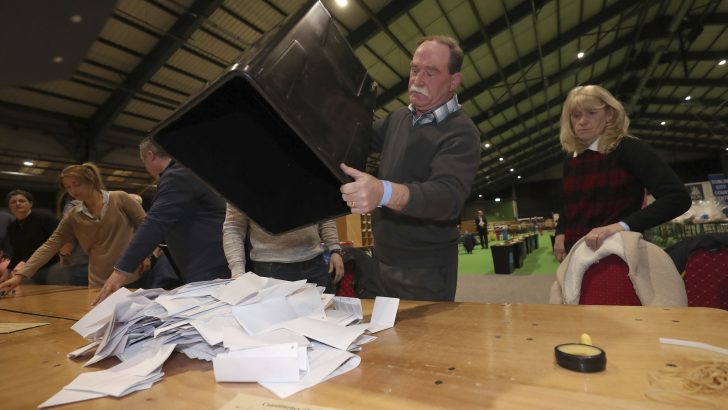The concerns of Catholics were invisible in the election because Catholics made themselves invisible, writes David Quinn
In the run up to the general election, there were a handful of statements from bishops such as Eamon Martin, Kevin Doran and Alan McGuckian but for the most part the Church kept as low a profile as possible during the election.
For example, there was no joint statement from the hierarchy, or there were from the hierarchies of Scotland, and England and Wales prior to the December general election in Britain. In that country, at least one group of parishes sent out a questionnaire to all candidates in their area to obtain their position on various issues. In this country, none that I am aware of did that.
Why the difference? I think one big reason is that we have become very defeatist. We have been extremely badly rocked by the scandals and continual negative coverage of the Church. We saw how bad it was in the run-up to the visit by Pope Francis to the country in August 2018 and the depleted crowds for him.
It’s interesting to compare the relative fortunes of Sinn Féin and the Catholic Church in light of last week’s election. Sinn Féin, like the Church, is scandal-ridden. It has countless skeletons in its closet and voters were reminded of them as election day drew near. But it is still proud of the IRA and is unrepentant about the campaign of violence in the North, even if it regrets some of the civilian casualties.
It has had sex abuse scandals which it covered up and lots of allegations of bullying of party members by other party members.
But here it is now, full of confidence and self-belief having achieved its best ever election result in the south. Its history of violence, the scandals, its continued alleged connection to the IRA army council have not held it back this time.
Strong support
What’s more, its strongest support was among young voters, who tend often to be the most disdainful of the Church, partly due to the scandals. It also grew its support considerably among middle-aged voters who are old enough to remember the IRA at its bloody height but still decided to forgive and forget and vote Sinn Féin.
Why isn’t Sinn Féin’s unrepented, violent past holding it back in the way it should be, while the Church, which has repented of its scandals many times, remains scared to offer a truly prophetic and evangelistic voice to society, or even its own people? Why is the public more forgiving of one than the other? Why does one remain self-confident, while the other is so drained of confidence?
I will leave those questions hanging there because they go beyond the scope of this short article, but they are worth pondering.
Do we know how Mass-going Catholics voted in the election? Actually, we do, because the RTÉ exit poll revealed it.
For a start, of those who voted, 31% attend church on a weekly basis or more.
Of the three main parties, Sinn Féin’s supporters are least likely to be regular church-goers. Just 17% attend church at least once a week. This would partly be a function of age, social class (middle class people are more likely than working class people to be Mass-goers), but also of ideology.
Fianna Fáil has the highest number of regular church-goers of the big three at 46%, which is well above the national average.
Fine Gael has received no visible public boost from its aggressive pursuit of a very socially liberal programme”
Of Fine Gael voters, 35% go to church once a week or more.
In the case of both Fianna Fáil and Fine Gael, this would partly be a function of age, social class, and the rural-urban divide.
Aontú, the party formed by Peadar Tóibín after he split with Sinn Féin over its pro-abortion stance, has easily the highest number of regular Mass-goers among its supporters. A huge 91% of its voters go to church at least once a week. It attracted just under 2% support nationally, which is quite good for a tiny new party with almost no money or media backing.
It would have done even better if a lot more of the 720,000 people who voted pro-life in the 2018 referendum had voted more tactically this time. In many cases they obviously reverted back to old party loyalties.
Attitude
On the other hand, Fine Gael has received no visible public boost from its aggressive pursuit of a very socially liberal programme. There was no electoral reward waiting for it.
It would also be interesting to know if the ultra-aggressive attitude of the likes of Simon Harris and Kate O’Connell towards pro-life voters did Fine Gael harm? It is as if the party was actively trying to alienate such voters.
Pro-choice position
Nor did Fianna Fáil receive any boost from switching to a pro-choice position. Micheál Martin bent over backwards to attract younger, urban voters, especially in Dublin, and the policy completely and utterly failed.
None of the main parties made the slightest effort to attract back some of the pro-life voters, probably for fear of a media backlash and possibly a voter backlash, even though the segment of the electorate that is the most pro-choice would be very slow to support Fine Gael, never mind Fianna Fáil.
None of the main parties made the slightest effort to attract back some of the pro-life voters”
Going forward, a greater political consciousness needs to develop among Catholics. The Church has rich social teachings to draw on and a well worked-out idea of the common good. These ought to influence how practising Catholics vote, even if they don’t dictate (and shouldn’t) that we must all vote one way.
But they should have some bearing on us, and until and unless they do, politicians will continue to ignore Catholics and we can hardly complain if we won’t do anything about it.


 David Quinn
David Quinn Ballot boxes are opened at the start of the Irish General Election count
Photo: Niall Carson/PA via AP/Time.com
Ballot boxes are opened at the start of the Irish General Election count
Photo: Niall Carson/PA via AP/Time.com 